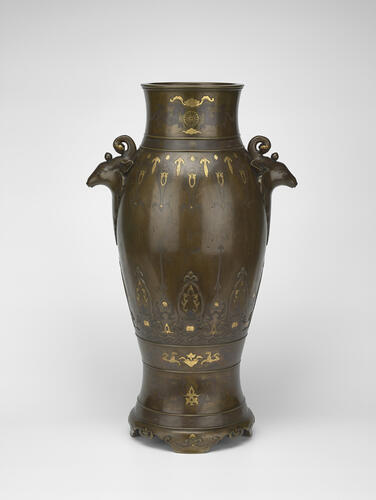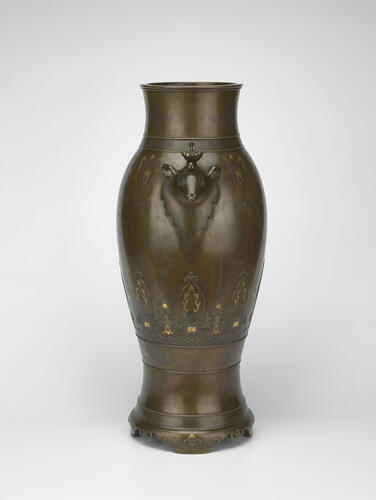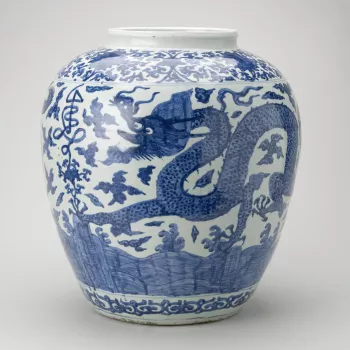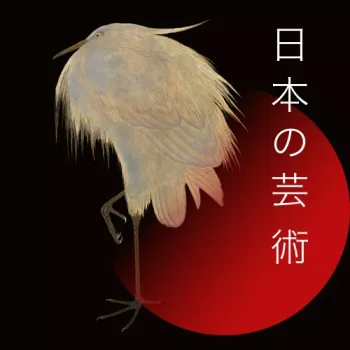Pair of vases c.1880-1882
Brass (copper alloy), gold, silver, shibuichi and copper, partly patinated | 51.0 x 28.0 x 28.0 cm (whole object) | RCIN 70174
-
These vases appear to have been among the gifts sent to Queen Victoria by the Emperor Meiji and presented by his envoy Prince Arisugawa Taruhito on 25 November 1882. The prince was a member of the Japanese Council of State and a general in the Imperial Japanese Army. The purpose of his 1882 voyage was ostensibly to negotiate with Alexander III of Russia, but he also visited Britain before travelling to the United States of America to meet President Ulysses S. Grant. Queen Victoria described his visit to Windsor in her Journal, noting that ‘The Prince is very small, but a great personage in Japan. He made a speech in a very low voice … and presented me with 2 beautiful closionné enamel vases & an inkstand’. The Illustrated London News similarly recorded the visit but noted only that ‘his Imperial Highness’ [brought] ‘presents of Japanese workmanship’. Queen Victoria may have misunderstood the techniques used on these objects or perhaps mistook the colourful surface of the inlaid metals for enamel. Whatever the reason, the historic inventories certainly list the vase as one of the emperor’s gifts, and its provenance may be confirmed by the incorporation of the chrysanthemum mon into the design on either side of the neck, indicating an imperial commission.
Pair of tall, slender vases, with sides tapering to a low, spreading foot with incurving shoulder, a pair of deer-head handles and a brief, narrow neck and cupped mouth. The projecting mouth rim inlaid with a band of T-fret pattern in silver. Round the neck, a pair of mythical animals flanking a central imperial chrysanthemum mon badge in applied relief, and below the shoulder, between two ribs, a decorative band in applied silver gilt with precious emblems among waves, including the shell, fish and a pair of clappers. Below the rib beneath, another fretwork border in silver. Above the foot, between two ribs, a flower-scroll border in gold and silver, and above this, a band of overlapping lotus petals in black, gold and silver, bordered in coppery red.
These are rare examples of a craft not much practised in Japan, where most bronze objects were traditionally small items of personal wear such as sword fittings. It was the decline of the military arts of the samurai class in later times that led metalworkers, such as those of the Kaga school in north-western Japan, to start making wares such as these vases, the decoration of which is at times elaborate.
Text adapted from Chinese and Japanese Works of Art in the Collection of Her Majesty The Queen: Volume III and Japan: Courts and Culture (2020)Provenance
Acquired by Queen Victoria, 25 November 1882. Presented by the Meiji emperor of Japan. Listed in the Windsor Castle Catalogue of Bronzes, c.1872, as no. 168 in Room 226.
Visible on the mantelpiece in The Oak Room at Windsor Castle in a photograph taken c.1890-95 (RCIN 2935640). -
Creator(s)
(place of production)(nationality)Acquirer(s)
-
Medium and techniques
Brass (copper alloy), gold, silver, shibuichi and copper, partly patinated
Measurements
51.0 x 28.0 x 28.0 cm (whole object)
Category
Object type(s)
Other number(s)
Place of Production
Japan














